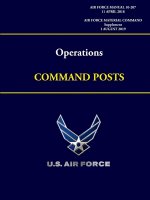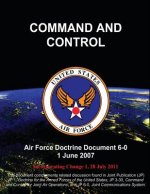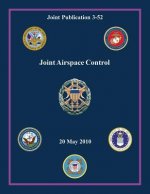
Code: 08144061
Joint Airspace Command and Control
by Jason D Wolf
Unmanned aircraft systems (UAS) are on the rise in the skies over today's battlefield. Their use, once isolated to surveillance and reconnaissance, has expanded to air interdiction, targeting, communications relay, base and convoy ... more
- Language:
 English
English - Binding: Paperback
- Number of pages: 58
Publisher: Biblioscholar, 2012
- More about this

56.85 €
RRP: 57.98 €
You save 1.13 €

In stock at our supplier
Shipping in 15 - 20 days
You might also like
-

Command and Control of Joint Air Operations: Joint Publication 3-30
14.78 € -1 % -

Creating Resilience: Ego Strengthening Hypnosis Scripts
25.85 € -

Murder at Teal's Pond
12.87 € -24 % -

Operations - Command Posts (Air Force Material Command - Supplement) Air Force Manual 10-207
20.12 € -1 % -

Joint Airspace Control: Joint Publication 3-52
15.69 € -2 % -

Command and Control
15.79 € -1 % -

Joint Airspace Control (Joint Publication 3-52)
13.48 € -2 % -

Stolen Boy
14.38 € -24 % -

Ride Through Asia Minor and Armenia
27.87 € -18 % -

Double and The Gambler
14.18 € -26 % -

Service Parts Planning with SAP SCM (TM)
105.05 € -

Queen of the Arena and Other Stories ... Illustrated by Millais and Others.
36.42 € -

Description of a New Universal Equatoreal, Made by Ramsden, with the Method of Adjusting It for Observation. as Also Instructions for Making Observati
12.87 € -18 % -

discourse of standing armies; shewing the folly, uselesness, and danger of standing armies in Great Britain. By Cato. The second edition.
13.68 € -18 %
Give this book as a present today
- Order book and choose Gift Order.
- We will send you book gift voucher at once. You can give it out to anyone.
- Book will be send to donee, nothing more to care about.
More about Joint Airspace Command and Control
You get 143 loyalty points
 Book synopsis
Book synopsis
Unmanned aircraft systems (UAS) are on the rise in the skies over today's battlefield. Their use, once isolated to surveillance and reconnaissance, has expanded to air interdiction, targeting, communications relay, base and convoy security, and even close air support. Unfortunately, the services have not planned well for this expansion of roles and numbers of platforms in the congested airspace over the battlefield. Traditional means of separating traffic, using airspace control measures, do not optimize use of the limited airspace, and are not sufficient to preclude mid-air collisions. The services are proposing several technology-driven initiatives to increase situation awareness for battlefield commanders, UAS operators, and TAGS airspace management personnel. This paper looks at three: the Army's Battle Command Network/Air Defense and Airspace Management initiatives in its Future Combat Systems BCT (FBCT); the Tactical UAV Coordinator Workstation (a UAV Battlelab / Army Space and Missile Command joint effort); and the AFRL Joint Airspace Management and Deconfliction (JASMAD) program. All three of these efforts use new technologies to allow better interoperability between A2C2 and TAGS, enabling quicker airspace deconfliction for more responsive UAS taskings and safer interoperability with manned assets and ground fires. This paper proposes ways to use and improve upon these three efforts. Their use in the present command and control structure can be optimized to promote centralized control and decentralized execution. This paper satisfies research requests proposed by the Chief of Staff of the Air Force on UAS deconfliction, as well as the Institute for National Security Studies in two areas: UAS proliferation in the battlespace, and the growing number of service-specific UAS.
 Book details
Book details
Book category Books in English Society & social sciences Education
56.85 €
- Full title: Joint Airspace Command and Control
- Subtitle: A Net-Centric Approach to Safely Integrating Uas
- Author: Jason D Wolf
- Language:
 English
English - Binding: Paperback
- Number of pages: 58
- EAN: 9781249840893
- ISBN: 9781249840893
- ID: 08144061
- Publisher: Biblioscholar
- Weight: 122 g
- Dimensions: 246 × 189 × 3 mm
- Date of publishing: 17. October 2012
Trending among others
-

Cambridge IGCSE (R) & O Level Complete Chemistry: Student Book Fourth Edition
42.46 € -

Cambridge IGCSE (R) & O Level Complete Physics: Student Book Fourth Edition
41.96 € -

Jim Trelease's Read-aloud Handbook
16.80 € -27 % -

Cambridge IGCSE (R) & O Level Complete Biology: Student Book Fourth Edition
39.24 € -

Powerful Teaching: Unleash the Science of Learning
26.26 € -26 % -

Oxford IB Diploma Programme: IB Economics Course Book
62.28 € -

OET Preparation
9.75 € -

Business Partner B1+ Workbook
16.90 € -3 % -

Oxford IB Diploma Programme: IB Theory of Knowledge Course Book
57.96 € -

Speed and Accuracy: Multiplication
8.64 € -

Pearson Edexcel International GCSE (9-1) English Language B Student Book
50.41 € -

KS3 Maths 10-Minute Weekly Workouts - Year 7
8.04 € -8 % -

KS3 Maths 10-Minute Weekly Workouts - Year 8
8.04 € -8 % -

The End of Education
13.48 € -25 % -

Deep Healing and Transformation
48.30 € -

Dancing Heads
12.17 € -24 % -

Freiarbeitsmaterial für die Grundschule - Deutsch - Klasse 1/2
22.83 € -4 % -

AQA GCSE German Higher Practice Papers
15.39 € -

Business Partner B1 Workbook
17.50 € -8 % -

Business Partner B2 Workbook
16.90 € -3 % -

Blue Book of Grammar and Punctuation: An Easy- to-Use Guide with Clear Rules, Real-World Examples , and Reproducible Quizzes, Twelfth Edition
15.19 € -28 % -

Grade 9-1 GCSE Maths AQA Revision Question Cards - Higher
10.05 € -4 % -

Positive Discipline Tools for Teachers
17.40 € -18 % -

Speed and Accuracy: Division
8.64 € -

Pearson Edexcel AS and A level Mathematics Statistics & Mechanics Year 1/AS Textbook + e-book
17.80 € -

(ISC) SSCP SG & SSCP Practice Test Kit, 3e
84.02 € -5 % -

Motivation and Reinforcement
46.38 € -

Read Write Inc. Phonics: Red Ditty Book Bag Books (Mixed Pack of 10)
74.36 € -

Imagine If...
11.26 € -28 % -

OET Reading Subtest Preparation
12.57 € -7 % -

Vol 2 Blackletter Lettering Adventures
25.35 € -1 % -

AS & A Level Maths For Dummies
17.30 € -27 % -

Forensic Linguistics Articles
14.48 € -1 % -

CompTIA Security+ Review Guide - Exam SY0-601
24.85 € -24 % -

Practical Guide on Veterinary First Aid using Homeopathy
14.78 € -2 % -

Abolition of Man
18.71 € -1 % -

Human Landscapes from My Country
28.67 € -21 % -

Corrected Squares of The Book of Abramelin
503.88 € -

Hanbo Jutsu: Use of Hanbo, Cane and Walking Stick for Self Defense
11.36 € -

Reading Mind - A Cognitive Approach to Understanding How the Mind Reads
21.53 € -28 % -

North Korea's Military Threat
25.45 € -

English Language & Literature WORKBOOK: York Notes for GCSE (9-1)
8.95 € -9 % -

Release Your Inner Drive
15.09 € -18 % -

Effect of Registration Errors on Tracking in a Networked Radar System
56.85 € -1 % -

Princeton Review SAT Premium Prep, 2021
42.66 € -4 % -

CEH v11 Certified Ethical Hacker Study Guide + Practice Tests Set
74.76 € -5 % -

10 Practice Tests for the SAT, 2021 Edition
31.59 € -

OCP Oracle Certified Professional Java SE 11 Programmer II Study Guide - Exam 1Z0-816 and Exam 1Z0-817
49.91 € -6 % -

Scrum - A Pocket Guide - 2nd edition
33.60 €
Collection points Bratislava a 2642 dalších
Copyright ©2008-24 najlacnejsie-knihy.sk All rights reservedPrivacyCookies


 15549 collection points
15549 collection points Delivery 2.99 €
Delivery 2.99 € 02/210 210 99 (8-15.30h)
02/210 210 99 (8-15.30h)